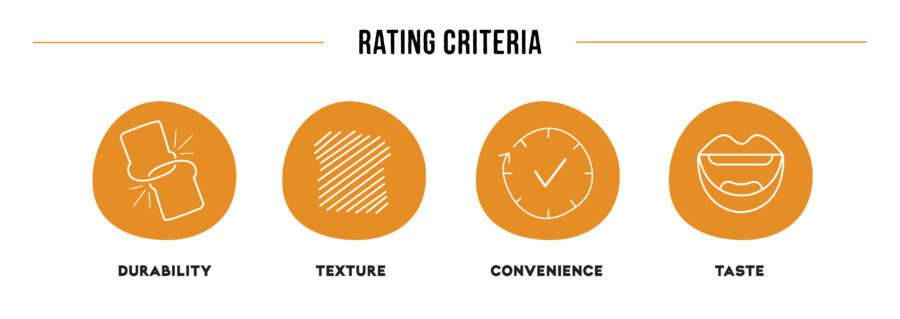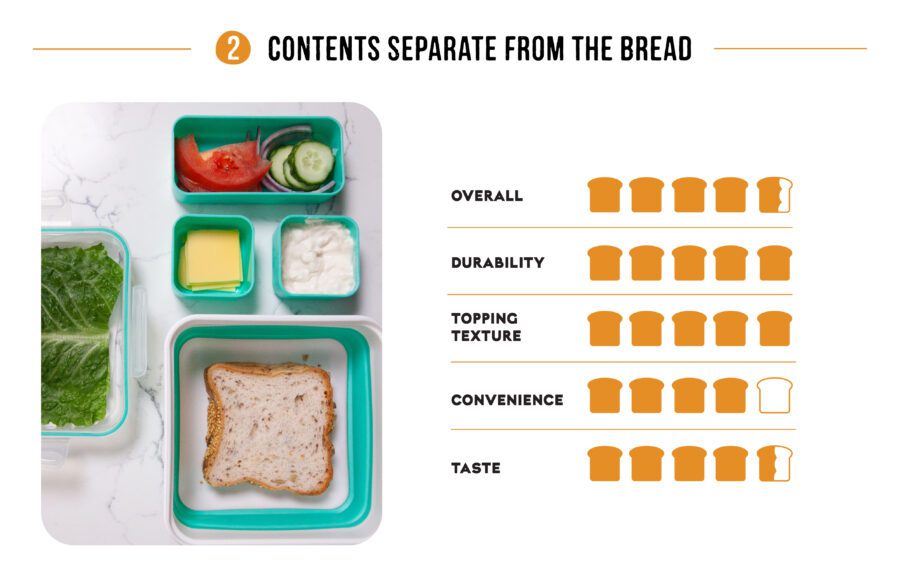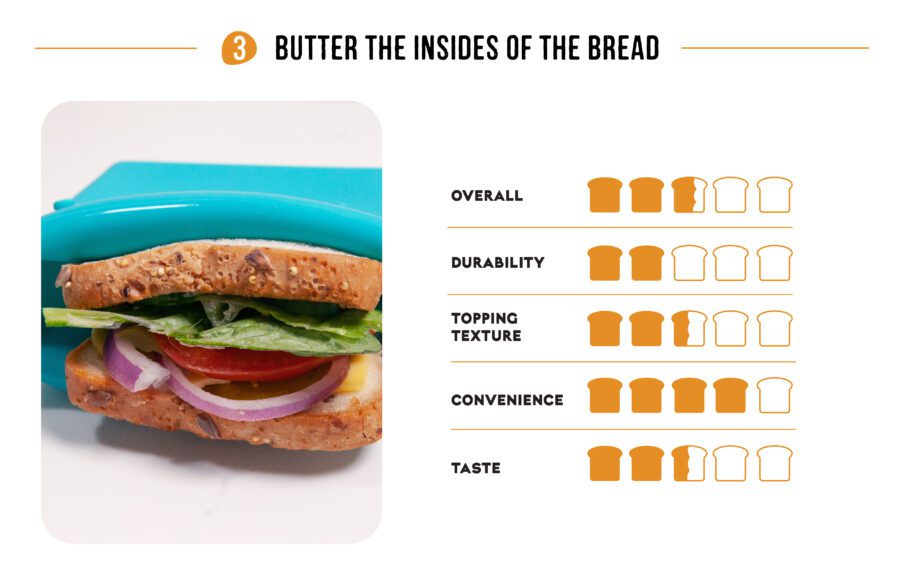Problem:
Packing a sandwich for later often leads to soggy bread and sad sandwiches for lunch the next day.
We want to know:
What’s the most optimal way to pack a sandwich so that it is just as good for lunch the next day as it would be if you ate it fresh off the cutting board.
Controls:
- Featured bread: Seeds & Grains
- Fillings:
- Romaine lettuce
- Sliced tomato
- Sliced cucumber
- Sliced pickles
- Thinly sliced red onion
- Sliced non-dairy cheddar (we used VioLife Slices)
- Vegan mayo (1 1/2 tablespoon per sandwich, spread in a thin layer on each side
- 1 × Packed separate in a standard container with a lid
- 3 × Packed in silicone baggies
- Stored in the fridge overnight
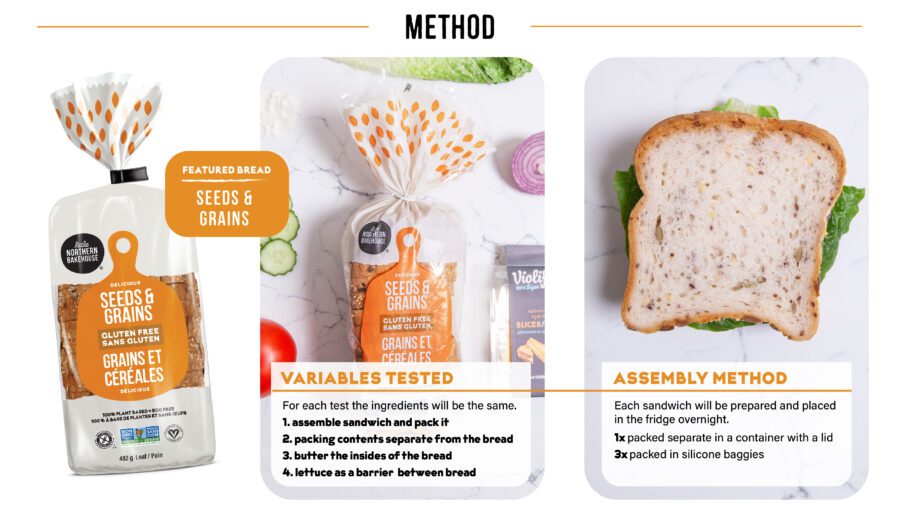
How to Make the Perfect Packed Sandwich
To determine the best way to pack the perfect sandwich we tested four different methods and scored each of them in four categories:
- How Does The Bread Hold Up: Is it soggy? Does it maintain the structural integrity you expect from a sandwich?
- Toppings Texture: How do the ingredients and contents of the sandwich hold up? Is the lettuce crisp? Is the cheese wilted? Is the tomato mushy?
- Convenience: Is this method easy and simple? Is it convenient? Would you actually take these steps to ensure a perfect sandwich?
- Overall Taste: How does it taste?
Packing the Sandwich As-Is (Control Test)
The typical way to pack a sandwich is to assemble your sandwich, throw it in a bag and off you go. Set it and forget it! This method is simple, but can often lead to a sad, unsatisfying, and soggy sandwich for lunch the next day. This is the method we will compare against all other methods of packing. The goal? Find the best way to pack a sandwich for lunch the next day that will hold its integrity, shape, and texture until its time to eat.
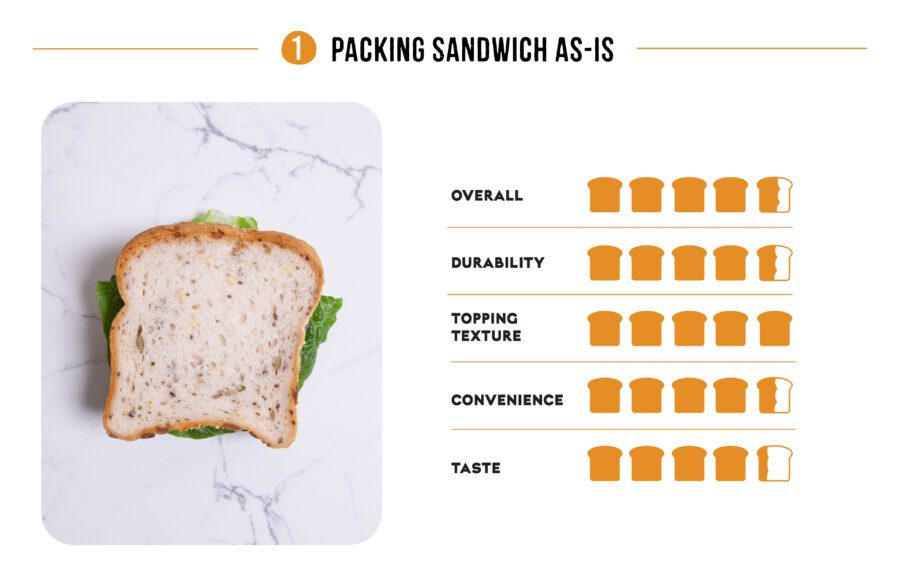
Pros
- Bread stayed fresh
- Flavour of ingredients remained consistent and easy to enjoy
Cons
- Bread appeared to be a bit dryer in the centre, yet slightly soggy around the crust area
Packing Contents of Sandwich Separate From the Bread
Packing the contents of your sandwich separately is a great way to ensure the bread does not absorb any moisture and become soggy. Although this resulted in a slightly dryer bread, an easy workaround for this is to add a spread of mayo to your sandwich—this brings loads of flavour to your sandwich and helps to counteract the dryness of the bread. If you have the time and capacity to pack your ingredients separate from your bread, we highly recommend it!
Pros
- Bread stayed fresh, and all ingredients remained crisp
- Taste of ingredients remained consistent and easy to enjoy
Cons
- Bread was slightly dryer than the other options
Butter the Insides of the Bread
Although we know people who swear a protective layer of moisture-proofing butter is the secret to non-soggy bread, our tests of this method produced the exact opposite result. In our testing, we found zero redeeming qualities of the sandwich produced from this method. We do not recommend this method of packing a sandwich. The flavour and texture were ruined by the combination of mayo and butter, drowning out all other ingredient flavours, and resulted in the soggiest bread of any method. We do not recommend this method of packing a sandwich!
Pros
- None whatsoever
Cons
- The butter and mayo together overpowered the other flavours of the sandwich in an unappetizing way.
- The bread in this test was the soggiest of all the methods we tested.
Using Lettuce as a Barrier Between the Ingredients and the Bread
Because the mayo was applied directly to the lettuce as opposed to the bread, ingredients slid around and did not stay in place. This made the sandwich very difficult to hold eat, and resulted in a very messy lunch. Overall, this method proved to be ineffective—the control method produced a higher-quality sandwich.
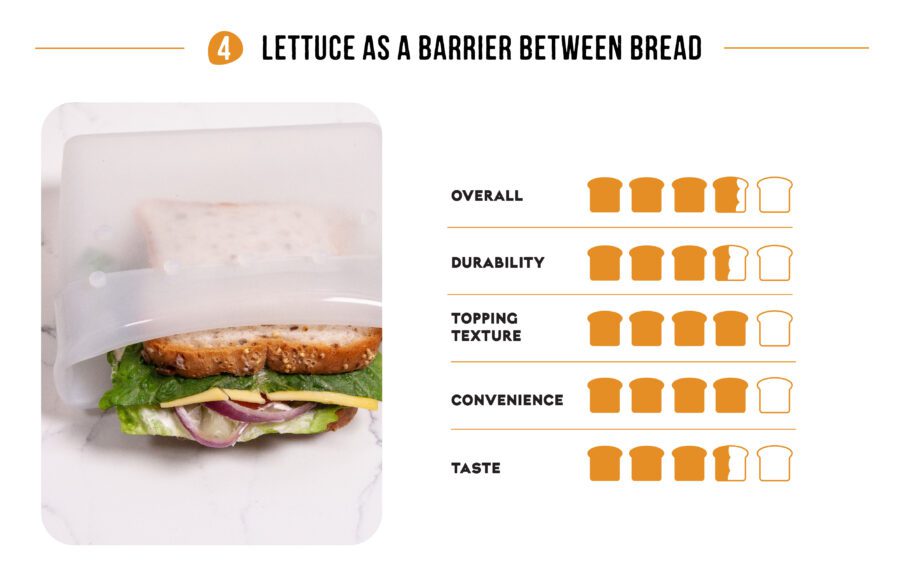
Pros
- For the most part, ingredients stayed crisp and maintained their flavour and integrity.
Cons
- Inconsistent texture. Bread was very dry except for a few spots where the mayo slid off the lettuce. One corner became very soggy because of this. (So much so that a piece of the sandwich broke off under its own weight.)
The Best Way to Pack a Sandwich
When it comes to packing the perfect sandwich, the best method is to pack your ingredients separate from the bread and assemble the sandwich when you’re ready to eat. This ensures the ingredients maintain their shape, texture, flavour and integrity—and the same goes for the bread.
Most of the other methods we tested resulted in a sad, soggy, and unsatisfying sandwich. Overall, your best bet is to pack the contents of your sandwich separately (if you have the time and capacity). The next best option would be to pack your sandwich as-is. But remember: the more moisture your ingredients hold, the more likely you are to end up with a soggy sandwich for lunch. And nobody wants that! So if you’ve got a juicy, summer-ripe tomato or love to pile on the pickles, we highly recommend you pack your ingredients separately and assemble your sandwich when hunger hits for a fresh off the cutting board sandwich wherever your day takes you.
For more gluten-free resources, sign up for our monthly newsletter at the bottom of this page. Check out our other gluten-free test kitchens for more tips on making the best gluten-free french toast, and post your makes to Facebook, Instagram, and Pinterest. (Don’t forget to tag us!)
